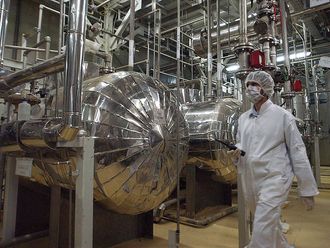Beirut: Syria’s militant-dominated Idlib province is the last major area remaining mostly out of regime control after more than seven years of civil war.
The northeastern province is home to some three million people - around half of them displaced from other parts of the country that have been recaptured by advancing Russian-backed Syrian regime forces.
Here is some background.
Falls in 2015
The province shares a border with rebel-backer Turkey and is also adjacent to Latakia, a regime stronghold on the Mediterranean coast that is home to Bashar Al Assad’s clan.
Before fighting broke out in 2011, most of Idlib’s inhabitants worked in agriculture, mainly growing cotton and cereals, or commuted to neighbouring Aleppo province.
In March 2015 a coalition of fighters including some linked to Al Qaida seized the provincial capital.
Hardliners come out on top
Hardcore extremist factions have since overpowered more moderate rebels.
Around 60 per cent of Idlib is controlled by Hayat Tahrir Al Sham (HTS), led by Syria’s former Al Qaida affiliate, with other hardliners also present.
The rest is held by the National Liberation Front (NLF), an alliance formed in August that merged Islamist groups Ahrar Al Sham and Nour Al Deeb Al Zinki with other rebel factions.
The NLF, which has Turkey’s backing, is meant to counter the growing power of HTS.
Dumping ground
Idlib province and adjacent slivers of opposition territory count some three million residents.
They include tens of thousands of rebels and civilians transferred since 2014 from former opposition bastions recaptured by the regime in notorious “reconciliation” deals.
The United Nations has warned that, in case of a massive regime assault to take back the province, there is “no other Idlib” for the province’s residents to flee to.
Chemical attacks
Government forces have been accused of several chemical attacks in Idlib.
A UN commission has found that helicopters from two regime-controlled air bases had dropped chlorine-filled barrel bombs on two Idlib villages in 2014 and 2015.
In October 2016 the commission concluded that the army also carried out a chemical attack, probably with chlorine, at a third village in 2015.
A sarin gas attack in April 2017 hit the town of Khan Shaikhun, killing 83 people, according to the UN. The Syrian Observatory for Human Rights said 87 died, including more than 30 children.
The UN blamed the government, which has consistently denied responsibility.
From de-escalation to new target
In 2017 Idlib province was one of four “de-escalation” zones established by the three main power brokers of Syria’s conflict - Russia, Iran and Turkey - in a bid to reduce violence.
However, in December, regime forces backed by Russian air power launched an offensive to recapture its southeast.
After weeks of intense fighting they had control of dozens of villages and towns, and the military airport of Abu Duhur.
The province became a priority for the government after its Russia-backed victories against rebel holdouts in Eastern Ghouta, near Damascus, and in the south earlier this year.
“Now Idlib is our goal,” Al Assad said on July 26.
Buffer zone agreed
On August 9 regime forces shelled some areas and dropped leaflets urging people to surrender.
Russian air raids struck the province over several days from September 7, raising fears that an all-out assault was imminent.
In apparent breakthrough after a flurry of meetings between key players in the conflict, regime ally Russia and rebel backer Turkey announced on September 17 a deal to create a demilitarised buffer zone in the province.
The agreement, which would separate rebel and regime forces, meant there would be no military action against Idlib, Russian Defence Minister Sergei Shoigu said.











